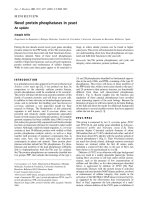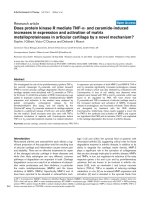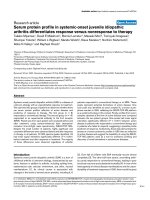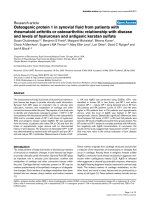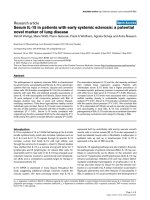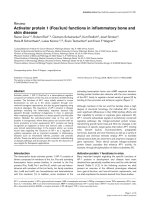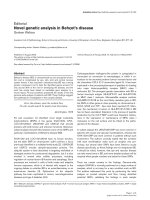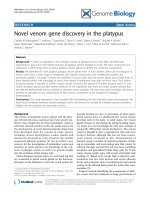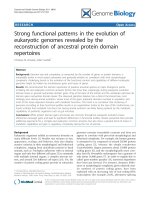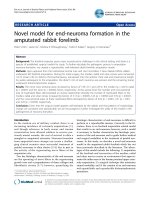Báo cáo Y học: Novel protein phosphatases in yeast docx
Bạn đang xem bản rút gọn của tài liệu. Xem và tải ngay bản đầy đủ của tài liệu tại đây (128.11 KB, 6 trang )
MINIREVIEW
Novel protein phosphatases in yeast
An update
Joaquı
´
n Arin
˜
o
Department de Bioquı
´
mica i Biologia Molecular, Facultat de Veterina
`
ria, Universitat Auto
`
noma de Barcelona, Bellaterra Spain
During the last decade several novel yeast genes encoding
proteins related to the PPP family of Ser/Thr protein phos-
phatases have been discovered and th eir functional charac-
terization initiated. Most of these novel phosphatases
display intriguing structural features and/or are involved in a
number of impo rtant functions, such as cell cycle regulation,
protein synthesis and maintenance of cellular integrity.
While in some cases these genes a ppear to be restricted to
fungi, in others similar proteins can be found in higher
eukaryotes. This r eview will summarize the l atest a dvances in
our understanding about how these phosphatases are regu-
lated and fulfil their func tions in the yeast cell.
Keywords: Ser/Thr protein phosphatases; cell cycle; cell
integrity; cation tolerance; protein synthesis; yeast.
INTRODUCTION
In a splendid cartoon that appeared in Trends in Biochemical
Sciences a few years ago [1], it was pointed out that, by
comparison to the relatively uniform protein kinases,
protein phosphatases could be considered to be ÔeccentricÕ.
This review will deal with the most eccentric members of this
family of eccentric proteins, and will focus on yeast cells.
In addition to their relevance in biotechnological processes,
yeasts, and in particular the budding yeast Saccharomyces
cerevisiae, represent a very important model for basic
research in biology. The biochemistry of this eukaryotic
organism is well known, and S. cerevisiae allows very
powerful and relatively simple experimental approaches
based on both classical a nd molecu lar genetics. Its complete
genomic sequence has been available since 1996 (it was the
first eukaryotic genome fully sequ enced) and th is knowledge
has been an important reference for research in other model
systems. Although a relatively simple o rganism, S. cerevisiae
contains at least 30 different proteins with verified or likely
protein phosphatase catalytic activity, as well as a large
number (still growing) of regulatory components that, in
many cases, have very close structural and functional
counterparts in plants and animals. These protein phos-
phatase activities include Ser/Thr phosphatases, Tyr phos-
phatases and members of the dual phosphatase subfamily,
able to dephosphorylate both Ser/Thr and Tyr residues.
Ser/Thr proteins phosphatases are commonly classified i nto
two groups: PPP, that includes the homologs of the type 1,
2A and 2B phosphatases identified by biochemical approa-
ches in the early 1980s, and PPM, consisting of the type 2C
phosphatases. This review will focus on those members of
the P PP family that, w hile in most c ases related to the type 1
and 2A proteins in their primary structure, are functionally
different from those well characterized phosphatases
(Table 1, Fig. 1). R ecent i n sights i nto t he function and
regulation o f the se a typical phosphatases have unveiled
most interesting aspects of the yeast biology. Because the
limitation of s pace we will focus m ainly in the latest findings
in this field and direct the reader for additional background
information to several excellent reviews that have appeared
within the last few years [1–3].
PPZ1/PPZ2
This group is composed by two S. cerevisiae genes, PPZ1
and PPZ2 [4–6], and similar genes identified in Schizosac-
charomyces pombe and Neurospra crassa [7,8]. These
proteins display C-terminal catalytic domains of about
300 residues that are 75–90% identical each other, a nd all of
them share about 60% identity with the catalytic subunit of
protein phosphatase-1 (Fig. 1). Their N-terminal moieties
are much less closely related, although common structural
features are retained within the first 40 amino acids,
including a conserved Gly2 that, in the case of Ppz1, has
been shown to be myristoylated in vivo [9].
Deletion of PPZ2 in an otherwise wild-type background
does not result in a readily d etectable phenotype. Strains
lacking Ppz1 are prone to cell lysis under certain circum-
stances, such as the presence of low c oncentrations of
caffeine and this effect, as for other phenotypes described
below, is aggravated by deletion of PPZ2 [10]. Ppz1
functionally interacts with the protein kinase C-activated
mitogen activated protein (MAP) kinase pathway, involved
in maintenance of cellular integrity, that results in the
activation of the Slt2/Mpk1 MAP kinase (reviewed in [11]),
as suggested by the observations that overexpression of
Ppz1 or Ppz2 suppresses the lytic phenotype of a mpk1
mutant, whereas deletion of the PPZ1 gene or inhibition of
Correspondence to J. Arin
˜
o, Department de Bioquı
´
mica i Biologia
Molecular, Facultat de Vete rina
`
ria, Universitat Auto
`
noma de
Barcelona, Bellaterra 08193, Ba rcelona, Spain.
E-mail:
Abbreviations: MAP kinase, mitogen activated protein kinase; TOR,
target of rapamycin; PP1, type 1 protein phosphatase; PP2A, type 2A
protein phosphatase; TPR, tetratricopeptide repeats.
(Received 6 August 2001, revised 3 October 2001, accepted 5 October
2001)
Eur. J. Biochem. 269, 1072–1077 (2002) Ó FEBS 2002
the phosphatase activity resulted in a phenotype additive to
that of t he mpk 1D mutant [ 5,12]. The molecular basis of this
functional interaction is unknown, but recent evidence
indicates that both Ppz1 and Sit4 phosphatases can
modulate, in an opposite fashion, the phosphorylation state
and activity of the Slt2/Mpk1 kinase (see below).
Strains lacking Ppz1 display a strong phenotype o f
hypertolerance to sodium or lithium cations, which is
enhanced by additional deletion of PPZ2 [13]. This is, at
least in part, the result of an increase in the expression of the
ENA1 gene, encoding a P-type Na
+
-ATPase which repre-
sents the major determinant for sodium tolerance in
budding yeast. The effect on ENA1 expression is independ-
ent and opposite to the effect described for the Ser/Thr
phosphatase calcineurin, a positive effector of the ATPase
gene [13,14]. However, an Ena1-independent role of Ppz1 in
salt tolerance cannot be discarded, because it has been
recently reported that overexpression of the Sky1 protein
kinase increases sensitivity to LiCl in a m anner that i s
dependent on the function of PPZ1 but not of ENA1 [15].
Very recent genetic and biochemical evidence points to the
Trk1 potassium transporter system as a target of Ppz action
(L. Yenush, J. Arin
˜
o & R. Serrano, unpublished results).
The identification of Ppz1 as an important element in
sodium tolerance a llowed t he establishment of a link
between t his phosphatase and t he HAL3/SIS 2 gene product
(see also below), because HAL3 was identified as a gene
able, when overexpressed, to increase tolerance to sodium
cations in a calcineurin-independent manner [16]. Genetic
and biochemical evidence supports the proposal that Hal3
acts as a negative regulatory subunit of Ppz1 and inhibits the
activity of the phosphatase by binding to its C-terminal
catalytic moiety [12].
A remarkable feature of Hal3 is that this protein appears
to regulate most of (if not all) Ppz1 functions [12]. For
instance, high-copy number expression of HAL3 in a slt2/
mpk1 background mimics the effect of deletion of PPZ1,
indicating that Hal3 regulates the function(s) of Ppz1 related
to the cell integrity pathway. Furthermore, it is known that
overexpression of Ppz1 leads to slow growth [9], a pheno-
type thatis suppressedby h igh-copy expressionof HAL 3 [12].
This situation appears rather different from the one
described for the GLC7 gene, encoding the single catalytic
subunit of type 1 protein phosphatase (PP1) in S. cerevisiae.
In this case, deletion of GLC7 results in lethality whereas the
absence of regulatory components y ields less dramatic
phenotypes, suggesting that the diverse cellular roles attrib-
uted to Glc7 are the result of specific interactions of the
catalytic subunit with different regulatory subunits. It must
be noted, however, that Glc7 and Ppz phosphatases might
share s ome common features. For instance, PPZ1 and
PPZ2 display genetic interactions with GLC7, as deduced
from the different growth defects observed in cells carrying
mutant alleles of GLC7 in combination with null alleles of
the PPZ phosphatases [17]. Furthermore, interactions
between Ppz1 and several known or putative regulatory
subunits of Glc7 (including Glc8, encoding a protein with
similarity to the mammalian inhibitor-2) have been docu-
mented by two-hybrid analysis [17]. These evidence suggests
that Glc7 and Ppz functions might overlap up to some
extent, and that Ppz1 shares a s ubset of Glc7 regulatory
subunits.
HAL3 is an allele of SIS2, a gene found as a multicopy
suppressor of the growth defect of sit4 mutants [18]. The
link between Hal3/Sis2 and Ppz1, together with the
observation that overexpression of PPZ1 resulted in slow
growth due to slow passage through G
1
/S [9] suggests a
functional connection between Ppz1 and Sit4 in the
regulation of cell cycle [19]. It was demonstrated that
deletion of PPZ1 partially rescued the growth defect of a
sit4 mutant, thus mimicking the effect of overexpression of
HAL3.Furthermore,lackofPPZ1 suppressed the s ynthetic
lethality of the sit4 hal3 and sit4 cln3 mutations. Therefore,
Table 1. Novel yeast Ser/Thr protein phosphatases. SN refers to the systematic gene name after the yeast gen omic sequencing pro gram. Size is
expressed in number of amino acids.
Subfamily SN Gene name Size Function
PP1
YML016c PPZ1 692 Regulates salt tolerance and cell cycle
YDR436w PPZ2 710 Regulates salt tolerance
YPL179w PPQ1/SAL6 549 Involved in protein synthesis
PP2A
YDR075w PPH3 308 Supply some PP2A-like function but also has specific roles
YDL047w SIT4/PPH1 311 Regulates G
1
/S cell cycle transition
YNR032w PPG1 368 Modulates glycogen synthesis
YGR123c PPT1 513 Unknown, similar in sequence to mammalian PP5
Fig. 1. Schematic depiction of the structure of yeast Ser/Thr protein
phosphatases described in this review. Black boxes refers to the con-
served catalytic domain common to the PPP family of Ser/Thr phos-
phatases. The asterisks denote the conserved motif for N-terminal
myristoylation.
Ó FEBS 2002 Novel protein phosphatases in yeast (Eur. J. Biochem. 269) 1073
Ppz1 appears as a novel regulatory component of the yeast
cell cycle, acting in an opposite way to Sit4.
The Ppz phosphatases are also involved in regulation of
protein translation. Two dimensional electrophoretic ana-
lysis of
32
P-labeled yeast cells revealed a prominent phos-
phoprotein that was shifted to more acidic regions in cells
lacking ppz1 ppz2 or in wild-type cells overexpressing HAL3
[20]. This protein was identified as the translation elongation
factor 1Ba (Tef5), the GTP–GDP exchan ging factor for
translation elongation factor 1. Tef5 appeared to be
phosphorylated in vivo at the conserved Ser86 and lack of
the Ppz phosphatases increased phosphorylation at this site.
Although it is not clear whether the translation factor is a
direct substrate for the phosphatase, it is evident that
regulation of the phosphorylation state of Tef5 by Ppz
results in modification of translation accuracy, as deduced
from the observation that ppz mutants display increased
tolerance to the drug paromomycine and increased read
through at nonsense codons [20]. The link between the Ppz
phosphatases a nd protein synthesis is reinforced by the
observation that affinity purified Ppz1 preparations contain
bound Ssb1 and/or Ssb2 (E. De Nadal, T. Haystead &
J. Arin
˜
o, unpublished observations). These proteins are
members of the HSP70 family [21] involved in the passage of
nascent chain through ribosome. Interestingly, although t he
double mutant ssb1 ssb2 is viable, it grows slowly at high
NaCl concentrations and exhibits hypersensitivity to
paromomycin, just t he opposite behaviour to that d isplayed
by ppz mutants.
As mentioned above, the fission yeast S. pombe and the
filamentous fungi N. crassa encode Ppz-like phosphatases
[7,8]. Comparison of yeast Ppz sequences with those
deposited in data banks suggest that this type of enzyme
might be restricted to fungi. This is somewhat surprising,
because homologs of HAL3 have been found in both plants
and animals [22]. Given the high sequence divergence at the
N-terminal half even between different fungi Ppz enzymes, it
might not be easy to identify an equivalent gene product by
sequence i dentity s earch in databanks from other organ-
isms. Deletion of S. pombe pzh1
+
results in cells hypertol-
erant t o Na
+
but hypersensitive to potassium ions [7],
pointing out that Pzh1 was involved in cation homeostasis.
However, a number of studies indicate that the mechanisms
of action of Pzh1 in S. pombe is different from that observed
for Ppz1 in budding yeast. For instance, cells lacking pzh1
do not show altered sodium or lithium efflux, but they
display decreased influx for t hese cations, a s well as reduced
K
+
efflux [23]. Furthermore, Pzh1 was unable to restore
wild-type tolerance to sodium cations in a S. cerevisiae ppz1
strain [24]. In contrast, expression of the N. crassa PZL-1
phosphatase from the PPZ1 promoter in S. cerevisiae ppz1
cells restored wild-type sensitivity to caffeine and s odium
ions. Furthermore, overexpression of PZL-1 induced
growth arrest in wild-type budding yeast and alleviated
the lytic phenotype of a slt2/mpk1 MAP kinase mutant,
suggesting that despite the marked divergence within their
N-terminal sequences, PZL-1 appears t o fulfil most of the
Ppz1 functions [24].
THE SIT4/PPH1 PHOSPHATASE
The gene SIT4 was i nitially cloned in a n screening for
restoration of HIS4 expression in strains lacking Bas1, B as2
and Gcn4 [25] and subsequently found to be necessary for
proper progression for the G
1
/S cell cycle transition [26,27].
The phenotype of sit4 cells depends on the polymorphic
SSD1 locus and results either in unviable cells (absence of
SSD1 or presence of ssd1-d alleles) or viable cells that show
a slow growth phenotype [26]. Sit4 is required in late G
1
for
progression into S phase and for expression of the CLN1
and CLN2 cyclins, as well as of the SWI4 transcrip tion
factor, in a pathway additive to that of CLN3. In addition,
bud emergence is also compromised in sit4 mutants, and
this defect appears to be independent of cyclin expression
[28]. O verexpression of human PP6 or Drosophila PP V
complements the cell growth defect of a sit4 mutant,
suggesting that they are functional homologs [27,29].
Sit4 associates w ith several proteins, known collectively as
SAP (for sit4-associated proteins), such as Sap155, Sap185,
Sap190 and p erhaps S ap4, in a cell cycle-dependent fashion.
Loss of all four SAP is equivalent to the loss of Sit4. All of
them function positively with Sit4, although they asso ciate
with the phosphatase in separate complexes and probably
have distinct functions [30]. It is not clear whether the Sap
proteins are modulator of Sit4 activity or substrates of the
phosphatase.
Sit4 also associates, in a SAP-independent fashion to
Tap42, an essential protein [31] that is phosphorylated by
the target of rapamycin (TOR) kinases [32]. Therefore, Sit4
appears involved in a pathway that links nutrient sensing
and cell growth [32,33] and that also involves the type 2A
protein phosphatase (PP2A) catalytic subunits Pph21 and
Pph22. Recent evidence suggests that Sit4 also interacts
physically and is regulated by the phosphotyrosyl phospha-
tase activators (PTPA) Ncs1/Rrd1 and Noh1/Rrd2 [34].
These proteins are also requ ired for regulation of a subset of
PP2A functions [35,36], supporting the proposal that Sit4 is
not the only target for these activators [34]. I n any case, t hey
must play a pivotal role in controlling progression through
the G
1
phase of the y east cell cycle as shown by t he fact that
deletion of both genes results in a lethal phenotype
[34,36,37].
As mentioned above, Sit4 and Ppz1 phosphatases play
opposite roles in regulating the G
1
/S transition. As a r esult, a
sit4 hal3 mutant (which lacks sit4 and presents an hyperac-
tivated Ppz1) is a rrested at G
1
and c annot grow [18,38]. This
situation has been exploited to find further components
involved in cell cycle progression by c onstructing a condi-
tional sit4 hal3 mutant [38] and searching for high-copy
suppressors (designated as VHS for viable sit4 hal3). Both
Pph21 and Pph22 phosphatases have been found among the
suppressor genes (Mun
˜
oz I., Simo
´
n, E., Arin
˜
o, J. and
Herrero, E., unpublished r esults), supporting the notion that
these PP2A phosphatases and Sit4 can share partially
overlapping function(s) [26]. Interestingly, a type 2C phos-
phatase, PTC2, can also support growth of the conditional
sit4 hal3 mutant. Other members of the yeast type 2C
family,suchasPTC1 and PTC3 also behave as VHS clones,
although with somewhat less potency. This screening has
also uncover a role for the Na
+
,K
+
/H
+
Nha1 a ntiporter i n
cell cycle, because high-copy expression of NHA1 allows
growth of a sit4 hal3 mutant. Despite the observation that,
under certain circumstances, Sit4 can influence monovalent
cation homeostasis and pH [39], the effect of Nha1 is most
probably independent of its a ntiporter a ctivity and suggest a
novel function for this protein [38].
1074 J. Arin
˜
o(Eur. J. Biochem. 269) Ó FEBS 2002
The functional connection between Sit4 and Ppz1 can
also be extended to the Pkc1/M pk1 pathway. Mpk1 is
phosphorylated and activated in response to several signals
related to cell integrity, such as cell wall stress (reviewed in
[11]). sit4 mutants display increased Mpk1 phosphorylation
under basal conditions, as well as under situations that
activate the pathway (De la Torre, M. A., Torres, J., Arin
˜
o,
J. and Herrero, E., u npublished results). This effect appears
to be independent of the role of Msg5 a nd Ptp2, two
phosphatases known to dephosphorylate Mpk1. An
increase in Mpk1 phosphorylation was also observed in
cells overexpressing Ppz1, while mutation of this phospha-
tase resulted in decreased Mpk1 phosphorylation. Evidence
has been gathered that the function of Sit4 might be
upstream of Pkc1, negatively regulating the activity of the
kinase (De la Torre, M . A., Torres, J., Arin
˜
o, J. and
Herrero, E., unpublished results).
SIT4 has been also cloned and characterized in the
budding yeast K luy verom yces l ac tis [40]. The protein is
highly similar to that of S. cerevisiae (93% identity) and it
has a bro ad role i n modulating multidrug resistance, both
positively and negatively. Recent evidence suggests that the
Pdr5 multidrug transporter can be a target for the
phosphatase [41].
PPH3
The PPH3 gene encodes a protein related t o t ype 2A
catalytic subunits (52% and 58% identity, respectively).
Although null mutants are viable, PPH3 gene function is
required for survival in the absence of PPH21 and PPH22
[42], suggesting that this protein has some biological
activity overlapping with that of PP2A. However, Pph3
function(s) probably differs from that of PP2A, because its
overproduction does not suppress the growth defect of
pph22
ts
mutants at 37 °C [43] and it has been described for
Pph3 a number of c atalytic features distinct from th ose of
PP2A, PPX or PP1 enzymes [44]. In addition, unlike
sit4 cla4 mutants, which are nonviable, pph3 cla4 mutants
grow even at 37 °C, suggesting t hat despite the relatively
high level of sequence similarity, Pph3 and Sit4 are
functionally unrelated. However, recent evidence have
linked the Pph3 phosphatase with the TOR signalling
pathway t hat regulates nitrogen catabolite r epression
through t he G ATA-type transcription factor Gln3 [45].
TOR k inase activity is required f or phosphorylation of
Gln3, thus inhibiting nuclear translocation of the t ran-
scription factor and maintaining repression of Gln3-
dependent genes. Expression of one of su ch genes,
GAP1, is strongly reduced after rapamycin treatment in
cells lacking Pph3, suggesting that this p hosphatase might
be directly or indirectly involved in dephosphorylation and
activation of Gln3. I t must be noted that, a lthough a
Tap42–Sit4 complex has been claimed as crucial for the
activation of Gln3 [33], controversial reports on this issue
can be found in the literature [46].
PPG1
The PPG1 gene was cloned by virtue of its sequence
similarity with other Ser/Thr phosphatases [47], although
the encoded polypeptide shows distinctive features, such a
C-terminal extension of about 50 residues directly following
the conserved catalytic domain. This extension has no
similarity with the C-terminal extension of type 2B catalytic
subunits and ends with the highly conserved DYFL
sequence found in type 2A phosphatases. In addition, an
internal insertion of 10 residues (from amino acids 205–215)
is found w hen comparing with PP2A or PP1 catalytic
subunits. D eletion of the PPG1 gene yields v iable cells
whose only known phenotype is a decrease in glycogen
accumulation [47]. The state of activation of glycogen
synthase was not modified by the absence of Ppg1 (in
contrast to that reported fo r other phosphatases known to
regulate glycogen metabolism, such as PP1 or PP2A) but its
amount was significantly r educed in ppg1 cells, in agreement
with the low glycogen levels. Interestingly, a recent large-
scale yeast two -hybrid screen for protein–protein interac-
tions [48] has revealed the possibility t hat Ppg1 m ay interact
with another Ser/Thr phosphatase, Ppt1 (see below). The
biological significance of this finding is unknown.
PPQ1/SAL6
The PPQ1 gene encodes a type1-related phosphatase
characterized by an N-terminal extension rich in Ser and
Asn, that is not related in sequence to those found in Ppz1
or Ppz2 [49]. Null ppq1 mutants are viable, altho ugh they
display reduced growth rate in different media, exhibit mild
defects in protein synthesis a nd are sensitive to several
protein synthesis inhibitors [49]. Multiple copies of SAL6
cause antisuppression of nonsense mutations [50,51] and
lack of Sal6 acts as an allosuppressor in suppressor strain
backgrounds (that is, enhances efficiency of translational
suppressors). These findings suggest a role for Sal6p in the
regulation of the fidelity of translation. It should be noted
that this situation is somewhat different from the one
described for the Ppz phosphatases, because ppz mutations
result in changes in t ranslational accuracy in an otherwise
wild-type background [20]. It has been reported that a ppq1
mutation do not show genetic interactions with ppz1 ppz2 or
diverse glc7 mutations [17].
PPT1
The protein encoded by PPT1 contains two distinct
domains: an N-terminal extension of almost 200 residues,
characterized by four tetratricopeptides repeats (TPR), and
a C-terminal domain that displays the typical f eatures of the
PPP family [52]. Proteins s imilar to S. cerevisiae PPT1 have
been found in S. pombe (clone SPBC3F6.01c) and N. crassa
[53]. However, Ppt1 is equally distant from PP2A and PP1
enzymes and, in fact, its closest relative is PP5, an ubiquitous
phosphatase in eukaryotic cells that also displays several
TPR motifs [52–55]. The TPR motif is a p rotein–protein
interaction structural element, often found in multiple c opies
in a number of functionally different proteins that f acilitates
specific interactions w ith partner protein(s). Most TPR-
containing proteins are associated with multiprotein com-
plexes; TPR motifs appear to be important for the function
of different protein families, such as chapero nes, transcrip-
tion, cell-c ycle and protein transport complexes (reviewed in
[56]). Mammalian PP5 has been implicated in several signal
transduction pathways, cell cycle regulation at G
1
and M
phases and, perhaps, regulation of potassium channels
(reviewed in [57]). In contrast, our knowledge on yeast Ppt1
Ó FEBS 2002 Novel protein phosphatases in yeast (Eur. J. Biochem. 269) 1075
has experienced little increase in the last few years. Deletion
of PPT1 results in no obvious change in phenotype . A recent
genomic t wo-hybrid screen reported interactions between
Ppt1 and two other proteins: the Ppg1 phosphatase,
described in this review, and Adr1, a zinc-finger transcrip-
tion factor required for glycerol metabolism and peroxisome
biogenesis. As in may other cases, the functional relevance of
these interactions remains to be elucidated.
CONCLUDING REMARKS
From the evidence outlined above, it is clear that these
ÔnovelÕ phosphatases play relevant roles in the biology of the
yeast (cell integrity, cell c ycle regulation, cation homeostasis,
etc) and that they interact with several key signalling
pathways. In some cases, such as Ppz1/Ppz2 and Sit4, our
knowledge on the regulation and function of these enzymes
has inc reased substantially within the last few years, while in
other cases, as Ppg1, many aspects still remain to be
elucidated. We should expect in the next few years that the
combination of classical approaches and g enome-wide
research (genomic microarrays, large-scale two hybrid
analysis, proteomics.) will give a powerful boost to t he
research in this field and p rovide new i nsight into the
regulation and function of these remarkable proteins.
ACKNOWLEDGEMENTS
Thanks are given to all colleagues t hat s hared unpublished observa-
tions. Research in the author’s laboratory has been supported by grants
PB98-0565-C04-02 (MCYT, Spain) a nd 1999 -SGR0010 0 ( CIRIT,
Generalitat de Catalunya).
REFERENCES
1. Cohen, P.T. (1997) Novel protein serine/threonine phosphatases:
variety is the spice of life. Trends Biochem. Sci. 22, 245–251.
2. Stark, M.J., Black, S., Sneddon, A.A. & Andrews, P.D. (1994)
Genetic analyses of y east protein serine/threonine p hosphatases.
FEMS Microbiol. Lett. 117, 121–130.
3. Stark, M.J. (1996) Yeast protein serine/threonine phosphatases:
multiple roles and diverse regulation. Yeast 12, 1647–1675.
4. Posas, F., Casamayor, A., Morral, N. & Arin
˜
o, J. (1992) Mole-
cular cloning and analysis of a yeast protein phosphatase with an
unusual amino-terminal region. J. Biol. Chem. 267, 11734–11740.
5. Lee, K.S., Hines, L.K. & Levin, D.E. (1993) A pair of functionally
redundant yeast genes (PPZ1 and PPZ2) encoding type 1-related
protein phosphatases function within the PKC1-mediated path-
way. Mol. Cell. Biol. 13, 5843–5853.
6. Hughes, V., M uller, A., Stark, M.J. & Cohen, P.T. (1993) Both
isoforms of prot ein phosphat ase Z are essential for the main-
tenance of cell size and integrity in Saccharomyces cerevisiae
response to osmotic stress. Eur. J. Biochem. 216, 269–279.
7. Balcells, L., Gomez, N., C asamayor, A., Clotet, J. & Arin
˜
o, J.
(1997) Regulation of salt tolerance in fission yeast by a protein-
phosphatase-Z-like Ser/Thr protein phosphatase. Eur. J. Biochem.
250, 476–483.
8. Szoor, B., F eh er, Z ., Zeke, T ., Gergely, P., Yatzkan, E., Y arden, O.
& Dombradi, V. (1998) pzl-1 encodes a novel protein phosphatase-
Z-like Ser/Thr protein phosphatase in Neurospora crassa. Biochim.
Biophys. Acta. 1388, 260–266.
9. Clotet, J., Posas, F., de Nadal, E. & Arin
˜
o, J. (1996) The NH
2
-
terminal extension of protein phosphatase PPZ1 has an essential
functional role. J. Biol. Chem. 271, 26349–26355.
10. Posas, F., Casamayor, A. & Arin
˜
o, J. (1993) The PPZ protein
phosphatases a re involved in the maintenance of osmotic stability
of yeast cells. FEBS Lett. 318, 282–286.
11. Heinisch, J.J., Lorberg, A., Schmitz, H.P. & Jacoby, J.J. (1999)
The protein k inase C-m ediated MAP kin ase pathway involved in
the maintenance of cellular integrity in Saccharomyces cerevisiae.
Mol. Microbiol. 32, 671–680.
12. DeNadal,E.,Clotet,J.,Posas,F.,Serrano,R.,Gomez,N.&
Arin
˜
o, J. (1998) The yeast halotolerance determinant Hal3p is an
inhibitory subunit of the Ppz1p Ser/Thr protein p hosphatase.
Proc. Natl Acad. Sci. USA 95, 7357–7362.
13. Posas,F.,Camps,M.&Arin
˜
o, J. (1995) The PPZ protein phos-
phatases are im portant determinants of salt to lerance in yeast cells.
J. Biol. Chem. 270, 13036–13041.
14. Mendoza, I., Rubio, F., Rodrı
´
guez-Navarro, A. & Pardo, J.M.
(1994) The protein phosphatase calcineurin is essential for NaCl
tolerance of Saccharomyces cerevisiae. J. Biol. Chem. 269, 8792–
8796.
15. Erez,O.&Kahana,C.(2001)Screeningformodulatorsofsper-
mine t olerance identifies S ky1, the SR protein kinase of Saccharo-
myces cerevisiae, as a regulator of p olyamine transport and ion
homeostasis. Mol. Cell. Biol. 21, 175–184.
16. Ferrando, A., Kron, S.J., Rios, G., Fink, G.R. & Serrano, R.
(1995) Regulation of cation transport in Saccharomyces cerevisiae
by the salt tolerance gene Hal3. Mol. Cell. Biol. 15, 5470–5481.
17. Venturi, G.M., Bloecher, A., Williams-Hart, T. & Tatchell, K.
(2000) Genetic interactions between GLC7, PPZ1 and PPZ2
Saccharomyces cerevisiae. Genetics 155, 69–83.
18. Di Como, C.J., Bose, R. & Arndt, K.T. (1995) O verexpression of
SIS2, which contains an extremely acidic region, increases the
expression of SWI4, CLN1 and CLN2 sit4 mutants. Genetics 139 ,
95–107.
19. Clotet, J., Garı
´
, E., Aldea, M. & Arin
˜
o, J. (1999) The yeast Ser/Thr
phosphatases Sit4 and Ppz1 play o pposite roles in regulation of the
cell cycle. Mol. Cell. Biol. 19, 2408–2415.
20. De Nadal, E., Fadden, R.P., Ruiz, A., Haystead, T. & Arin
˜
o, J.
(2001) A role for the Ppz Ser/Thr protein phosphatases in the
regulation of translation elongation factor 1Ba. J. Biol. Chem. 276,
14829–14834.
21. Pfund, C., Lopez-Hoyo, N., Ziegelhoffer, T., Schilke, B.A., Lo
´
pez-
Buesa, P., Walter, W.A., Wiedmann, M. & Craig, E.A. (1998) T he
molecular chaperone Ssb from Saccharomyces cerevisiae is a
component o f t he ribosome-nascent chain c omplex. EMBO J. 17,
3981–3989.
22. Espinosa-Ruiz,A.,B elle
´
s,J.M.,Serrano,R.&Culia
´
nez-Macia
´
,F.A.
(1999) Arabidopsis thaliana At HAL3: a flavoprotein related to salt
and osmotic tolerance and plant growth. Plant J. 20, 529–539.
23. Balcells, L., Calero, F., Go
´
mez, N., Ramos, J. & Arin
˜
o, J. (1999)
The Schizosaccharomyces pombe Pzh1 protein phosphatase regu-
lates sodium influx in a Trk1-independent fashion. Eur. J. Bio-
chem. 260, 31–37.
24. Vissi, E.,Clotet,J.,d eN adal,E .,Barcelo,A.,Bako, E.E., Gergely,P.,
Dombradi,V.&Arin
˜
o, J. (2001) Functional a nalysis of the
Neurospora crassa PZL-1 protein phosphatase by expression in
budding and fission yeast. Yeast 18, 115–124.
25. Arndt, K.T., Styles, C.A. & Fink, G.R. (1989) A suppressor of a
HIS4 transcriptional defect encodes a protein with homology to
the catalytic subunit of protein phosphatases. Cell 56, 527–537.
26. Sutton, A., Immanuel, D. & Arndt, K.T. (1991) T he SIT4 protein
phosphatase functions i n late G1 for progression into S phase.
Mol. Cell. Biol. 11, 2133–2148.
27. Mann, D.J., Dombradi, V. & Cohen, P.T. (1993) Drosophila
protein phosp hatase V functionally complements a SIT4 mutan t
in Sacc haro myces cerevisiae and its amino-terminal region can
confer this complementation to a heterologous phosphatase cata-
lytic dom ain . EMBO J. 12, 4833–4842.
1076 J. Arin
˜
o(Eur. J. Biochem. 269) Ó FEBS 2002
28. Ferna
´
ndez-Sarabia, M.J., Sutton, A., Zhong, T. & Arndt, K.T.
(1992) SIT4 protein phosphatase is required for the normal
accumulation of SWI4, CLN1, CLN2, and HCS26 RNAs during
late G1. Genes Dev. 6, 2417–2428.
29. Bastians, H. & Ponstingl, H. (1996) The novel human protein
serine/threonine phosphatase 6 is a functional homologue of
budding yeast Sit4p and fission yeast ppe1, which are involved in
cell cycle regulatio n. J. Cell Sci. 109, 2865–2874.
30. Luke, M.M., Della Seta, F., Di Como, C.J., Sugimoto, H.,
Kobayashi, R. & Arndt, K.T. (1996) The SAP, a new family of
proteins, associate and function positively with the SIT4 phos-
phatase. M ol. Cell. Biol. 16, 2744–2755.
31. Di Com o, C.J. & Arndt, K.T. (1996) Nutrients, via the Tor pro-
teins, stimulate the association of Tap42 with type 2A phospha-
tases. Genes Dev. 10, 1904–1916.
32. Jian, Y. & B roach, J.R. (1999) Tor proteins and protein phos-
phatase 2A reciprocally regulate Tap42 in controlling cell growth
in yeast. EMBO J. 18, 2782–2792.
33. Beck, T. & Hall, M.N. (1999) The TOR signalling pathway con-
trols nuclear localization of nutrient-regulated transcription f ac-
tors. Nature 402, 689–692.
34. Mitchell, D.A. & Sprague, G.F. Jr (2001) The phosphotyrosyl
phosphatase activator, Ncs1p (Rrd1p), functions with Cla4p To
regulate the G(2)/M transition in Saccharomyces cerevisiae. Mol.
Cell. Biol. 21, 488–500.
35. Van Hoof, C., Janssens, V., De Baere, I., de Winde, J.H.,
Winderickx, J., Dumortier, F., Thevelein, J .M., Merlevede, W. &
Goris, J. (2000) The Saccharomyces cerevisiae homologue YPA1
of the mammalian phospho tyrosyl phosphatase activator of pro-
tein phosphatase 2A controls progression through the G1 phase of
the yeast cell cycle. J. Mo l. Biol. 302, 103–120.
36. Van Hoof, C., Janssens, V., De Baere, I., Stark, M.J., de Winde, J.H.,
Winderickx, J., Thevelein, J.M., Merlevede, W . & Goris, J. (2001)
The Saccharomyces cerevisiae p hospho tyrosyl ph osphatase
activator proteins are required for a subset of the functions
disrupted by protein pho sphatase 2A mutations. Exp. Cell Res.
264, 372–387.
37. Rempola, B., Kaniak, A., Migdalski, A., Rytka, J., Slonimski,
P.P. & di Rago, J .P. (2000 ) Functional a nalysis of RRD1
(YIL153w) and RRD2 (YPL152w), which encode two putative
activators of the phosphotyrosyl phosphatase activity of
PP2A in Saccharo myc es ce revis iae . Mol. General Genet. 262, 1081–
1092.
38. Simo
´
n, E., Clotet, J., Calero, F., Ramos, J. & Arin
˜
o, J. (2001)
A screening f or high-copy suppressors of the sit4 hal3 synthetically
lethal phenotype reveals a role for the yeast Nha1 antiporter in cell
cycle regulation. J. Biol. Chem. 276, 29740–29747.
39. Masuda, C.A., Ramı
´
rez, J., Pen
˜
a, A. & M onte ro-Lo mel i, M.
(2000) Regulation of monovalent ion homeostasis and pH by the
Ser-Thr protein phosphatase SIT4 in Saccharomyces cerevisiae.
J. Biol. Chem. 275, 30957–30961.
40. Chen, X.J., Bauer, B.E., Kuchler, K. & Clark-Walker, G.D.
(2000) Positive and n egative control of multidrug resistance b y the
Sit4 protein phosphatase in Kluyveromyces lactis. J. Biol. Chem.
275, 14865–14872.
41. Chen, X.J. (2001) Activity of the Kluyveromyces lactis Pdr5
multidrug transporter is modulated by the Sit4 protein phospha-
tase. J. Bacteriol. 183, 3939–3948.
42. Ronne, H., Carlberg, M ., Hu, G.Z. & Nehlin, J .O. ( 1991) P rotein
phosphatase 2A in Saccharomyces cerevisiae: effects on cell growth
and bud morphogenesis. Mol. Cell. Biol. 11, 4876–4884.
43. Evans, D.R. & Stark, M.J. (1997) Mutations in the Saccharomyces
cerevisiae type 2A protein phosphatase catalytic subunit reveal
roles in cell wall integrity, actin cytoskeleton organization and
mitosis. Genetics 145, 227–241.
44. Hoffmann, R., J ung, S., Ehrmann, M. & H ofer, H .W. (1994) T he
Saccharomyces cerevisiae gene PPH3 encodes a protein phospha-
tase with properties different from PPX, PP1 and PP2A. Yeast 10,
567–578.
45. Bertram, P.G., Choi, J.H., Carvalho, J., Ai,W.,Zeng,C.,Chan,T.F.
& Zheng, X.F. (2000) Tripartite regulation of Gln3p by TOR,
Ure2p, and phosphatases. J. Biol. Chem. 275, 35727–35733.
46. Cardenas, M.E., Cutler, N.S., Lorenz, M.C., Di Como, C.J. &
Heitman, J. (1999) The TOR signaling cascade regulates gene
expression in response to nutrients. Genes Dev. 13, 3271–3279.
47. Posas, F., Clotet, J., Muns, M.T., Corominas, J., Casamayor, A.
&Arin
˜
o, J. (1993) The gene PPG encodes a novel yeast protein
phosphatase involved in glycogen accumulation. J. Biol. Chem.
268, 1349–1354.
48. Uetz, P., Giot, L., Cagney, G., Mansfield, T.A., Judson, R.S.,
Knight, J.R., Lockshon, D., Narayan, V., Srinivasan, M.,
Pochart, P. et al. (2000) A comprehensive analysis of protein–
protein i nteractions in Saccharomyces cerevisiae. Nature 403 ,
623–627.
49. Chen, M.X., Chen, Y.H. & Cohen, P.T. (1993) PPQ, a novel
protein phosphatase containing a S er + Asn-rich amino-terminal
domain, is involved in the regulation of protein synthesis. Eur. J.
Biochem. 218, 689–699.
50. Vincent, A., Newnam, G. & Liebman, S.W. (1994) The yeast
translational allosuppressor, SAL6: a n ew member of the PP1-lik e
phosphatase family with a long serine-rich N-terminal extension.
Genetics 138, 597–608.
51. Benko, A.L., Vaduva, G., Martin, N.C. & Hopper, A.K. (2000)
Competition between a sterol b iosynthetic enzyme and tRNA
modification in addition t o changes in the protein synthesis
machinery causes altered nonsense suppression. Proc. Natl Acad.
Sci. USA 97, 61–66.
52. Chen, M.X., McPartlin, A.E., Brown, L., Chen, Y.H., Barker,
H.M. & Cohen, P.T . (1994) A novel hum an protein serine/thre-
onine pho sphatase, which possesses fou r tetratricopeptide repeat
motifs and localizes to the nucleus. EMBO J. 13, 4278–4290.
53. Yatzkan, E. & Yarden, O. (1997) ppt-1, a Neurospora c rassa PPT/
PP5 subfamily serine/threonine protein phosphatase. Biochim.
Biophys. Acta. 1353, 18–22.
54. Becker, W., Kentrup, H., Klumpp, S ., Schultz, J.E. & Joost, H.G.
(1994) Molecular cloning of a protein serine/threonin e phosph a-
tase containing a putative regulatory tetratricopeptide repeat
domain. J. Biol. Chem. 269, 22586–22592.
55. Becker, W., B uttini, M., Limonta, S., Boddeke, H. & Joost, H.G.
(1996) Distribution of the mRNA fo r protein phosphatase T in rat
brain. Mol. Brain Res. 36, 23–28.
56. Blatch, G.L. & Lassle, M. (1999) The tetratricopeptide repeat: a
structural motif mediating protein–protein interactions. Bioessays
21, 932–939.
57. Chinkers, M. (2001) Protein phosphatase 5 in signal transduction.
Trends Endocrinol. Metab. 12, 28–32.
Ó FEBS 2002 Novel protein phosphatases in yeast (Eur. J. Biochem. 269) 1077
